|

Margay, a. k. a. tigrillo (Felis wiedi), Hormiguero, Campeche.
Wild Cats - Part 2
|
| Caracal (Felis caracal) is widespread,
but rare in the Middle East, parts of Central Asia and Africa. Surprisingly, caracals are said to make good pets.
They were used in Iran and India to hunt birds and small mammals. They need as
much walking as a hunting dog, and as much motion as a weasel. |
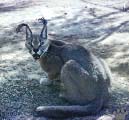 Asian caracal (F. c. schmitzi),
Asian caracal (F. c. schmitzi),
Arava Rift, Israel. |
Caracals have large
home ranges and can be extremely difficult to find. In places like Turkmenistan
or Egypt, even finding their tracks is a great luck. In Africa, they seem to prefer dry areas, but avoid sandy deserts. In Asia, they inhabit all types of desert, as well as savannas, river valleys, foothills, even dry woodlands. |

Baby African caracal
(F. c. caracal), Liboi, Kenya. |
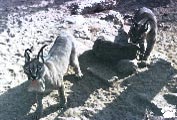
Caracals, Arava Rift, Israel. |
Only in Israel they
are more common and partly synantropic. This couple lived close to my cabin; I
fed them frozen chicken until they became relatively tame. Although they looked
like lynxes, their behavior was completely different. These cats were very short-tempered
and always aggressive to each other. They were strikingly fast, even as cats
go: I saw the male take six doves from a flock in one leap. |
| Sand cat (F. margarita
harrisoni) can be seen with little effort, but some luck, in sandy deserts
of Israel (unfortunately, there are few sandy areas only), or in Repetek
Nature Reserve, Turkmenistan (F. m. thinobia). You have to be a good
dasher: as soon as you catch a glimpse of cat's eyes reflecting your spotlight,
the animal will hide it's face (natural defense: face is the only bright-colored
part), and then run away in few seconds, so you'll have very short time to get
close for better view. In less dry areas, it is replaced by African wild cat
(F. silvestris lybica). |
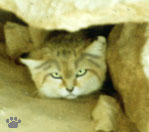
Sand cat, Gaza Strip, Israel. |


Pallas' cat, Valley of Big
Lakes, Mongolia. |
Other cats of Central Asia are
more difficult to see. Driving at night in Mongolian
grasslands, you can see one Pallas' cat (F. manul) in few weeks.
Pallas' cat is widespread in Central Asia, from Armenia to China, but it is so
rare outside Mongolia, that it can take more than a year to see one. In Central
Kazakhstan, Asian wild cats (F. s. caudata) can be seen in the same
way once in a few nights, but this species is extremely rare in Mongolia. Marsh
edges, rocky outcrops or boulder piles with pica colonies are the best place to
look for grassland cats, but flat plains can be also good if there are enough
voles, especially colonies of Chinese vole (Lasiopodomus brandti). All
small cats of open grasslands are more active in moonless nights. |
| For Jungle cat (F. chaus),
the best place is Kyzylagach Nature Reserve,
Azerbaijan. Cats can sometimes be seen walking along levees at night. They are
constantly on the move, and resemble foxes in their hunting habits. This species
is called "tule cat" in Caspian Sea area because of its preferred habitat
- large reed-covered areas. |

Jungle cat, Kyzylagach, Azerbaijan. |

Jungle cat, Gasan-Kuli, Turkmenistan. |
Jungle cat can also be seen at broad daylight if you set up a blind at the
water edge in an area of dense reeds with plenty of aquatic rodents, birds and
small fish. This species is highly vocal - its call resembles English exclamation
"Wow!" as spoken by a tobacco addict with heavy Midwestern accent. If
you hear it, try to attract the cat by imitating its call. |
| South American jaguar (Panthera onca onca)
can be best seen by swimming along forest rivers in
places like Manu Nat'l Park or, reportedly, forest reserves in Belize and Guyana.
This is also a good way to see ocelot (F. pardalis maripensis).
For other rainforest cats - mountain lion (F. concolor), margay
(F. w. amazonica) or jaguarundi (F. yaguarondi) - it's better
to wait on a low branch above a trail in upland forest (terra firma). For smaller
tiger cat (F. tigrinus guttula), and for another subspecies of margay
(F. w. wiedi), Bananal Island in Brazil is a good place. |

Black jaguar, Rio Manu, Peru. |
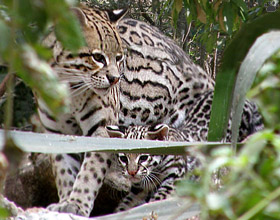 |
 |
| Ocelots, near Copan Ruinas, Honduras. |
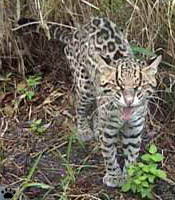
Sneezing ocelot, Crooked Tree, Belize. |
Trails or rivers connecting two large blocks of
forest can be used by cats and other animals every night. Narrow bands of gallery
forest along rivers, such as at Kinabatangan River, Sabah;
in Pantanal, Brazil; or in Northern Belize, are also good places to look for wild
cats or to wait for them in hides.
Ocelot video (3.123 Kb.mpg) |
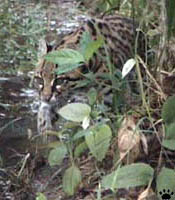
Ocelot (F. p. pardalis), Crooked Tree. |
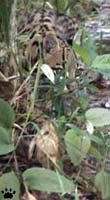 |
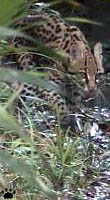 |
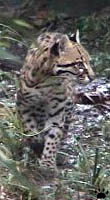 |
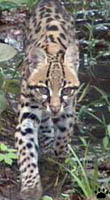 |
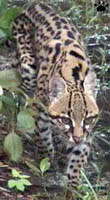 |
| Ocelot walking a riverside
trail, Crooked Tree Wildlife Sanctuary, Belize. |
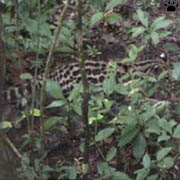
Margay, Hormiguero, Campeche. |

. |
Of all Neotropical cats, margay is the one most likely
to be seen near human settlements. It often raids henhouses or visits garbage
dumps in search of rats. It can survive even in badly degraded forests as long as there's enough tall trees left. |
 |
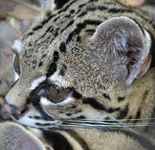
Margays, Pico Bonito National Park, Honduras. |
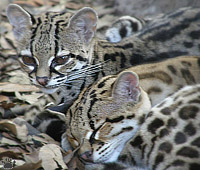 |

Margay, Pico Bonito National Park, Honduras. |
Margay is the most arboreal cat in the world. Its feet structure has unique adaptations to tree climbing.

Margay, Pico Bonito. |
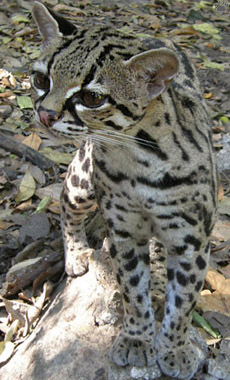
Margay, Pico Bonito National Park, Honduras. |
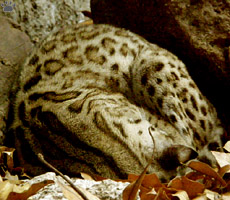
Margay, Pico Bonito National Park, Honduras. |
I have to admit that it's also my favorite cat species of the Americas. Margays seem to like me, too: I've met some unusually tame ones. |

Margays, Pico Bonito National Park, Honduras. |
| An interesting place to look for margays (F. w.
yucatanica) is in ancient Mayan cities of Mexico
and Central America. Larger ruins are usually too crowded during the day and guarded
at night, but small, remote places often have more wildlife than human visitors.
The pictures above and to the right are from a video obtained at dawn in Hormiguero,
a small 10th century Mayan complex within Calacmul Biosphere Reserve in Campeche,
Mexico. |
Like many forest cats, margay is perfectly camouflaged except for
white ear markings. They probably make it easier for half-grown cubs to follow
their mother while hunting together. |
 |
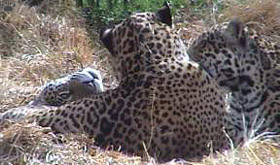 |
| Jaguars, Rio Beni Biosphere Reserve, Bolivia. |
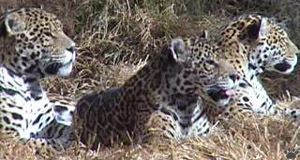
Jaguars, Rio Beni Biosphere Reserve. |
Jaguars are sometimes seen from forest or savanna roads. Of course, you might spend your entire life in South America and never see one, but sometimes you just get lucky. This trio was happily playing not far from a major highway in Rio Beni Biosphere Reserve. I think it was one male and two females. Don't ask me why there was three. |
 |
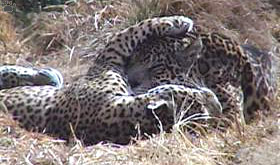 |
| Jaguars, Rio Beni Biosphere Reserve, Bolivia. |
| Normally jaguars are difficult to see, but they leave plenty of signs of their presence on forest trails: tracks, scratches and other territorial markings, sometimes kills. |
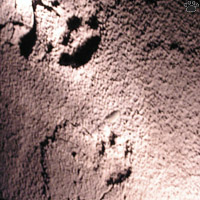
Jaguar tracks on a riverbank,
Madidi National Park, Bolivia
. |
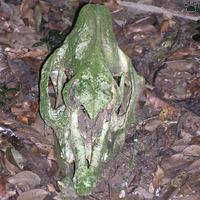
Skull of a lowland tapit (Tapirus silvestris)
killed by a jaguar, Madidi Naional Park. |
 |
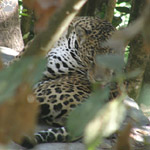
Jaguar, Rio Chajul, Guatemala. |
 |
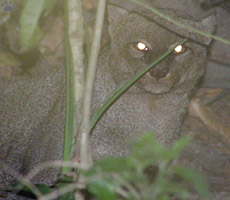
Jaguarundi, Rio Chajul, Guatemala. |
Jaguarundi, a weird little cat, looking like a mongoose or an otter, is especially common in dry forests from Chiapas to Panama. |
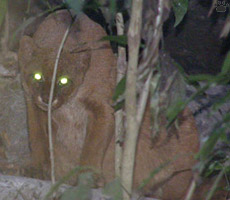
Jaguarundi, Rio Chajul, Guatemala. |
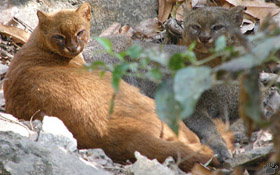 |
 |
| Jaguarundis, Rio Chajul, Guatemala. |
| This little jaguarundi was videotaped at night in a hollow tree
which was apparently used for shelter by a Mexican porcupine (Cendou mexicanus)
during daytime. I was lucky it wasn't a jaguar. |
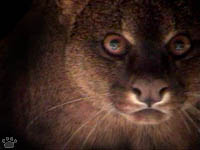 |
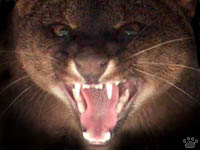 |
| Jaguarundi, Finca Ecologica, Costa
Rica. |
|

Fishing cat, Chitwan National
Park, Nepal. |
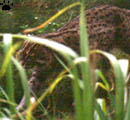
Bengal cat, China/Laos border
near Menghan, Yunnan. |
Swimming in forest
rivers of tropical Asia is the best way to see fishing (F. viverrina),
and smaller flat-headed (F. planiceps) cats. Both are partly aquatic.
Bengal cat (F. bengalensis), the most widespread and common cat
of Asian tropics, can be seen also by hiking at night, even in the vicinity of
forest villages. |
| Two races of Bengal cat are very difficult to see.
Iriomote cat (F. b. iriomotensis) lives only on one small island
in Southern Japan. Amur cat (F. b. euptilura), is not particularly
rare, but shy and hard to find. The best place to look for it is in isolated hill
forests within Khanka Lake coastal lowlands in
Ussuriland, Russia. Both these races are sometimes considered separate species.
An undescribed subspecies from the Philippines is
now very rare or extinct on all islands, except remote parts of Palawan. With
some luck, it can be found in Saint Paul Subterranean River Nat'l Park. Being
the only wild cat on the Philippines, it had originally inhabited a broad variety
of habitats, from grassy fields to montane rainforests and mangroves. Recently
hunting pressure caused it to disappear everywhere, except for the most impenetrable
forests and thicklets. Its pelts are still sold on Manila markets. |
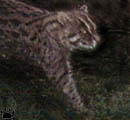
Amur cat, Novoselskoe, Russia.

Bengal cat tracks, St. Paul NP. |

Bengal cat, Gunung
Mulu, Sarawak. |
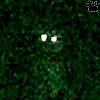
Flat-headed cat, Gunung
Mulu, Sarawak. |
In places where more than one species of small
cats occurs, identifying them might be tricky. To the left are video stills of
two cats the way you most often see them at night. Both were taken in Gunung Mulu Nat'l Park in Malaysian Borneo. It is one of the best places in Asia
to look for small cats, because forest boardwalks allow you to move easily and
quietly. |
| This is apparently the first photo of bay cat
(F. badia) ever taken in the wild. This small cat is related to Asian golden
cat, and occurs only on Borneo. It is considered very rare, but is regularly seen
in Danum Valley Conservation Area, Sabah. |
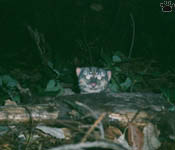
Bay Cat, Gunung Mulu, Sarawak. |
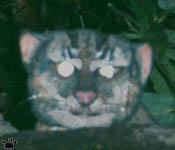
Same picture, enlargened. |
 |
 |
 |
 |
 |
 |
 |
| Mousing bobcat, Hicks
Mountain, California. |

Bobcat, Butano Creek,
California (snapshot
from video taken without
nightshot). |
Wild cats of the North are probably the most difficult ones
to see. It took me 18 months in USA to see such a common species as bobcat
(F. rufus). Look for it at night in lower portions of Sequoia
Nat'l Park. Forest-bordered meadows in coastal California are also good, particularly
at dusk and 1-2 hours before sunset. |

Bobcat, Butano Creek,
California (snapshots
from video taken with
nightshot). |
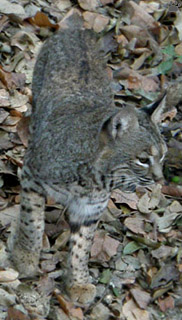 |
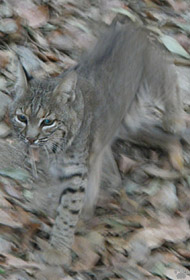
Bobcat, Fakahatchee Strand State Preserve, Florida. |
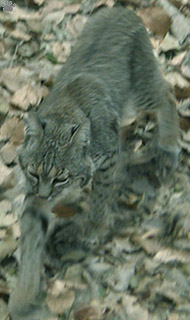 |
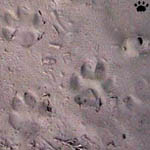
Usually cat tracks, such as these baby
bobcat tracks, have no clawmarks.
Wilderness Ridge, New Mexico. |
In desert areas, bobcats prefer riparian corridors,
so you have a good chance of seeing one if you hike quietly along wooded streams
or wait nearby. Try Buenos Aires Nat'l Wildlife Refuge, San Pedro Riparian Area,
and Aravaipa Canyon, all in Arizona. Bobcats and lynxes have long legs, and can
be easily mistaken for dogs in poor light or at distance. |

Here the kitten used its claws,
sliding on slippery mud,
Wilderness Ridge, New Mexico. |
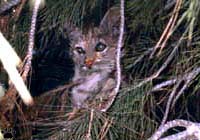 |

Young bobcat, Los Gatos, California.
Bobcat mating calls tapes are available in the US, but I've never tried them. |
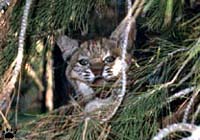 |
 |
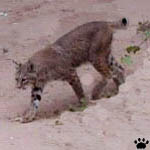
Bobcat, Sierra del Carmen, Coahuila. |
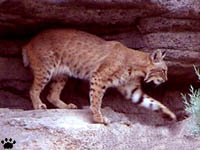 |
| Canadian lynx (F. canadensis) can
also be found by driving late at night. Roads to and within Wood
Buffalo Nat'l Park, Canada, are the best place I know. In June and July, nights
are very short here, so nocturnal animals can often be seen at twilight hours.
Still, midnight is the best time to look for lynxes. |
 |
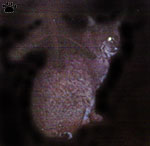 |
| Canadian lynx, Wood Buffalo Nat.
Park, Canada. |
|
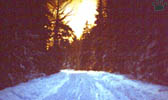
Habitat of the last lynx population in
Moscow area, Dubna River, Russia. |
European lynx (F. lynx lynx) is now extremely
rare in Europe. It is still hunted in many areas, and the last surviving animals
are so shy that seeing them is almost impossible. It took me two winters of tracking
to catch my first glimpse of lynx. For better chances, visit Central Forest Reserve
in westernmost Russia. Bielovezhski forest on Belorussia/Poland border and Pechoro-Ilychskii
Reserve in the Urals are also good places to try. |
| The largest lynx, Siberian lynx F. l. wrangeli,
is still relatively common in parts of Yakutia. Try looking for it from Kolyma
Highway in winter, better next year after solar activity maximum (there are
often Arctic hare outbreaks in such years). You can sometimes see it from the
highway, but you chances will be better if you hike 10-20 km away from any road.
Look for its tracks in the areas with lots of hares (usually along the edges of
riparian forests). |
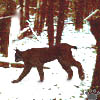
Lynx, Handyga, Yakutia. |
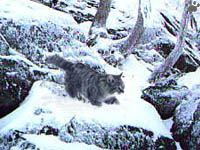
Caucasian wild cat, Krasnaya Polyana, Russia. |
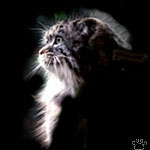
Pallas' cat, Moscow Zoo
(photographed in captivity). |
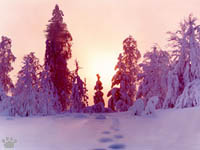
Lynx tracks, Polar Urals, Russia. |

Baxan river, Balkaria. |
European wild cat (F. silvestris silvestris)
is now declining or extinct in most parts of its range. It is, however, still
common in subtropical forests above Black Sea coast between Anapa, Russia, and
Sukhumi, Abkhazia. Roads leading to Ritza lake in Abkhazia and Terskol ski resorts
in Balkaria are also good locations. Wild cats sometimes patrol these roads just
before dawn. Caucasus Nature Reserve is another good
place to look for Caucasian wild cats (F. s. caucasia) at lower elevations, and for rare Caucasian lynx
(F. l. dinnikii) in coniferous forests. Try audio tapes with mating calls
of bobcat or Canadian lynx - they might also attract Eurasian lynxes. Or probably
not: calls of wild cats differ between species as much as those of songbirds. |
 |
 |
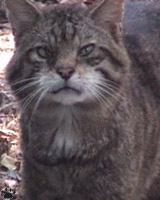 |
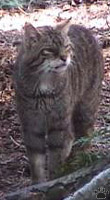 |
| Scottish cat, Loch Tay, Scotland. |
| A lot of people try to see wild cats in Scotland. Scottish wild cat (F. s. grampia) is rare and local, but not terribly shy. This one was so tame, I still suspect that it had been somehow habituated to people. But it was seen reasonably far from any settlements. |
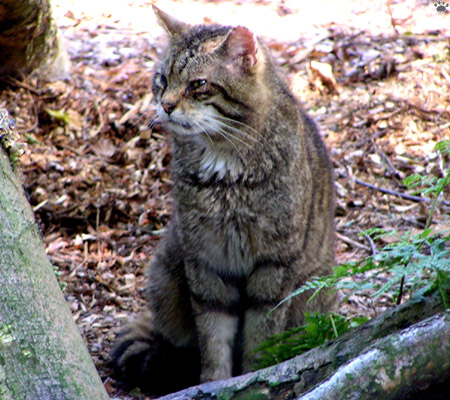
Scottish cat, Loch Tay, Scotland. |

1 - Asian wild cat, 2 - European wild cat (from: Vladimir Dinets,
Eugene Rotshild. Mammals of Russia. ABF, 1998).
Part Three
Back to Part One
Home
|

